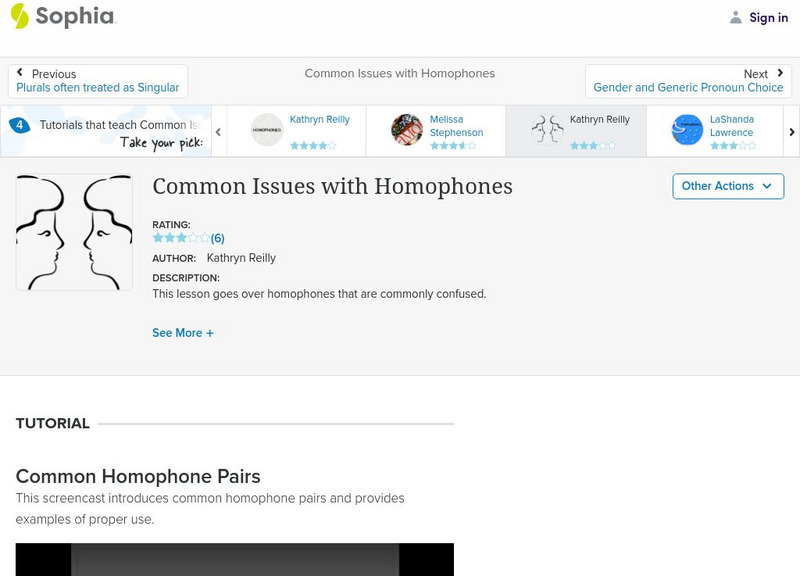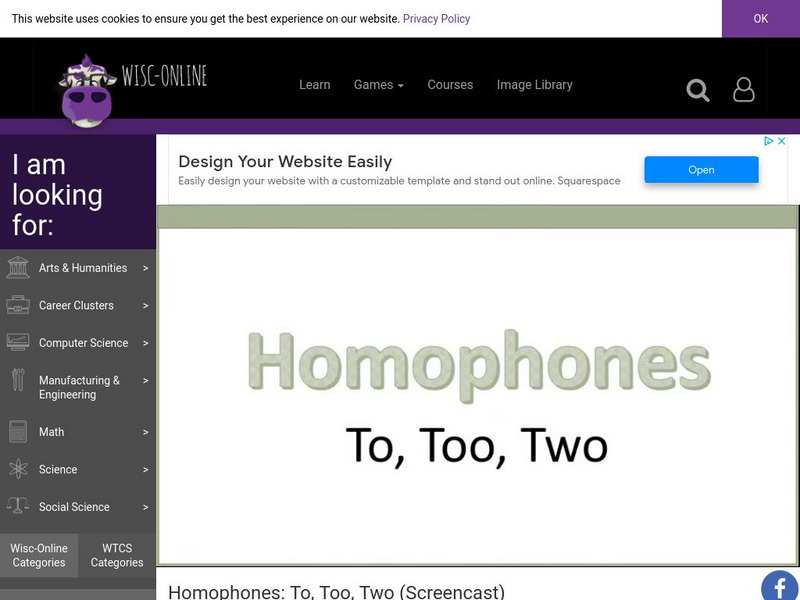Hi, what do you want to do?
Rachel's English
Homophones Part 5
In this English grammar video you will learn all of the common homonyms and homophones in the English language. Homophones and homonyms are difficult when you are learning English grammar and vocabulary. But in this video you learn all...
Rachel's English
Homophones Part 4
In this English grammar video you will learn all of the common homonyms and homophones in the English language. Homophones and homonyms are difficult when you are learning English grammar and vocabulary. But in this video you learn all...
Rachel's English
Homophones Part 3
In this English grammar video you will learn all of the common homonyms and homophones in the English language. Homophones and homonyms are difficult when you are learning English grammar and vocabulary. But in this video you learn all...
Rachel's English
Homophones Part 2
In this English grammar video you will learn all of the common homonyms and homophones in the English language. Homophones and homonyms are difficult when you are learning English grammar and vocabulary. But in this video you learn all...
Curated Video
One Minute English #5 - Learn Vocabulary Fast - Higher vs Hire
One Minute English #5 - Learn vocabulary fast with English Like a Native teacher Anna English. Today we will look at the homophones Higher and Hire. Please write a practice sentence below in order to solidify your knowledge and learn...
Curated Video
Waste vs Waist #shorts
Do you know the difference between the words 'waste' and 'waist'? What do you waste the most time doing?
Extra English Practice
Their, there, they're and other common homophones
Vocabulary lesson comparing three sets of common homophones: there/their/they're, it's/its, and your/you're. Fill in the blank activities and a BINGO game for practice.
Wonderscape
Commonly Confused Homophones
This program meets Common Core fourth grade language standards by introducing and differentiating between commonly confused homophones, such as aloud/allowed and who's/whose. Detailed graphics, diagrams and exciting video, as well as...
Curated Video
Mastering To, Too, and Two: Clearing Up Confusion
In this video, the teacher explains the correct usage of frequently confused words: to, too, and two. The teacher provides examples, definitions, and strategies for identifying and correcting mistakes. By following these guidelines,...
Wonderscape
Commonly Confused Homophones
This program meets Common Core 4th grade language standards by introducing and differentiating between commonly confused homophones, such as to/too/two and there/their/they're. Detailed graphics, diagrams and exciting video, as well as...
Curated OER
The Many Meanings of Cool
A very neat word with multiple meanings is the center of attention in a fun musical video. The Read Between The Lions team of Sierra, Lionel, Leona, Cleo, and Theo get together to sing a song defining the word cool. Kids will sing...
Curated OER
Telling a Story
Junior high and high schoolers watch a short video about effective storytelling strategies. As they take a virtual field trip to the Hans Christian Andersen story hour in Central Park, learners differentiate between writing a story and...
Curated OER
Homophones
Just because words sound alike doesn't mean they have the same definition. After viewing a short video about homophones, learners come up with their own list of homophones.
Sophia Learning
Sophia: Common Issues With Homophones
This lesson focuses on homophones; it defines the term and then discusses and provides examples for 9 word sets as follows: sea, bare, there, site, know, two, plain, be, and eye. Real Player is required.
Sophia Learning
Sophia: Commonly Confused Words
This lesson focuses on a list of commonly confuses words such as as/like, less/fewer, further/farther, than/then, that/which, amount/number, etc. It explains the differences in the meanings of the words and how to use them correctly....
Turtle Diary
Turtle Diary: Homophones
This TurtleDiary interactive video lesson [1:27] features information about homophones. Games and worksheets are provided to supplement this homophones lesson
Sophia Learning
Sophia: Common Issues With Homophones
This lesson focuses on homophones: words that sound the same, but have different meanings. First it explains the differences between homonyms and homophones; then it looks at a list of commonly confused homophones, their meanings, and,...
Sophia Learning
Sophia: Word With Multiple Meanings
This lesson focuses on determining the correct meaning of a word with multiple meanings. First it explains why words in English have multiple meanings. Then using the word "bear," it provides steps and examples for how to determine the...
Wisc-Online
Wisc Online: Homophones: To, Too, Two
This video focuses on the definition and proper usage for the homophones to, too, and two. [2:35]
Other
Mrs. Silva's Elementary Antics: Multiple Meaning Words
This video illustrates common multiple meaning words. [8:29]
Khan Academy
Khan Academy: To, Two, and Too
Another troublesome triad, 'to', 'two', and 'too'. Let's set these` frequently-confused words straight!
Khan Academy
Khan Academy: There, Their, and They're
This is one of the most frequently-confused trios in the English language. Follow along, and learn to suss out the differences between these three words.
Khan Academy
Khan Academy: Choosing Between Its and It's
David and Paige explain the meaning of two English words that look and sound very similar but act very different: _its_ and _it's_.


















